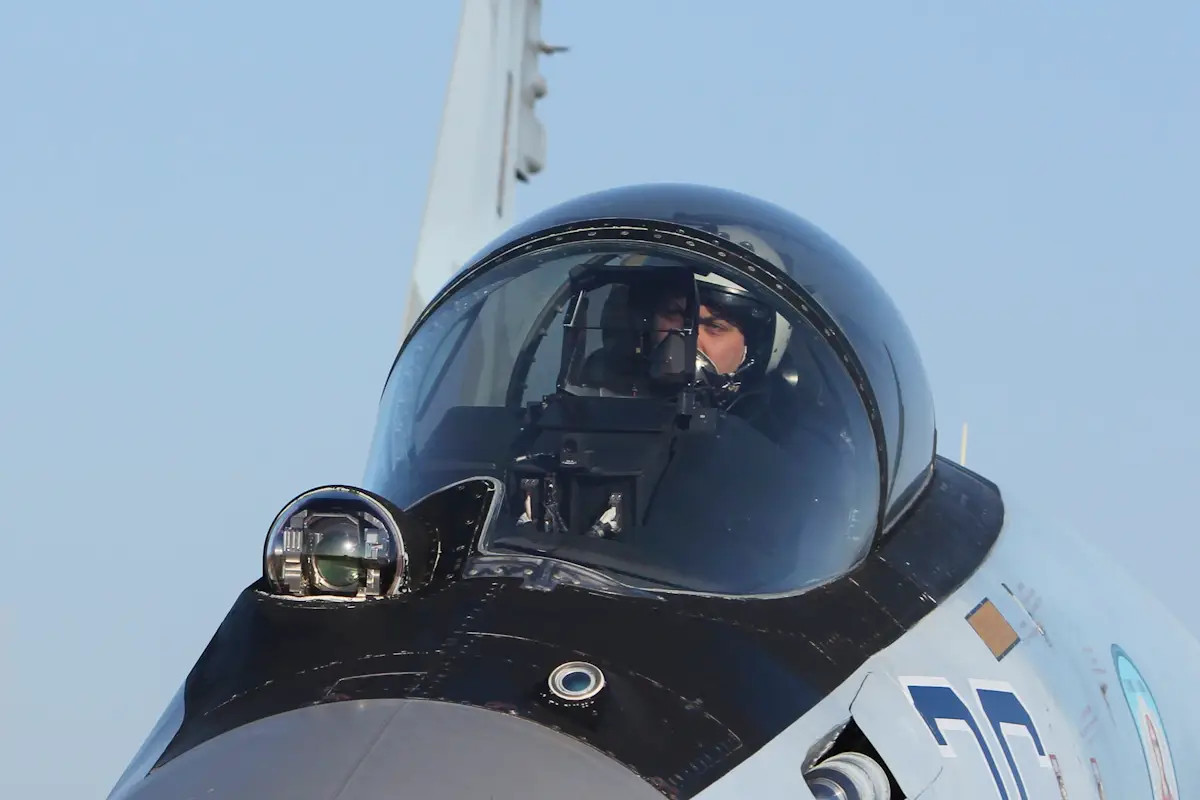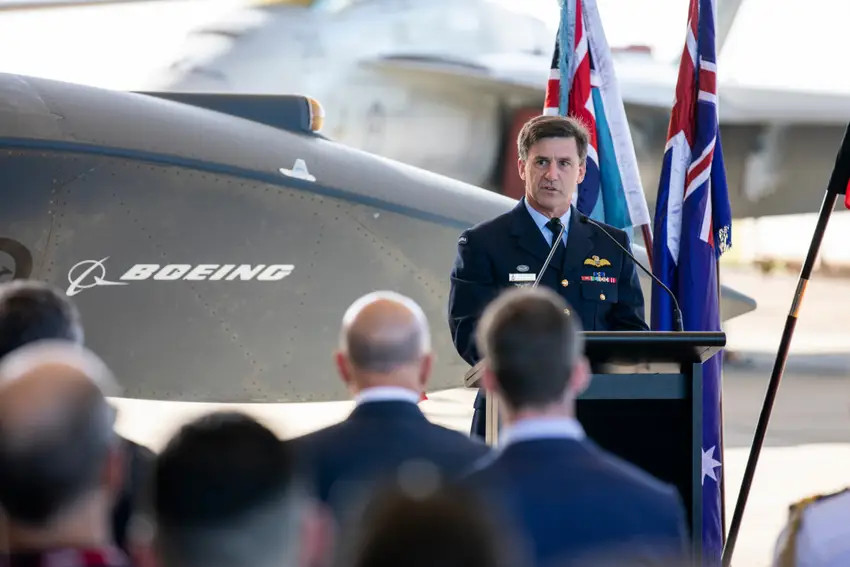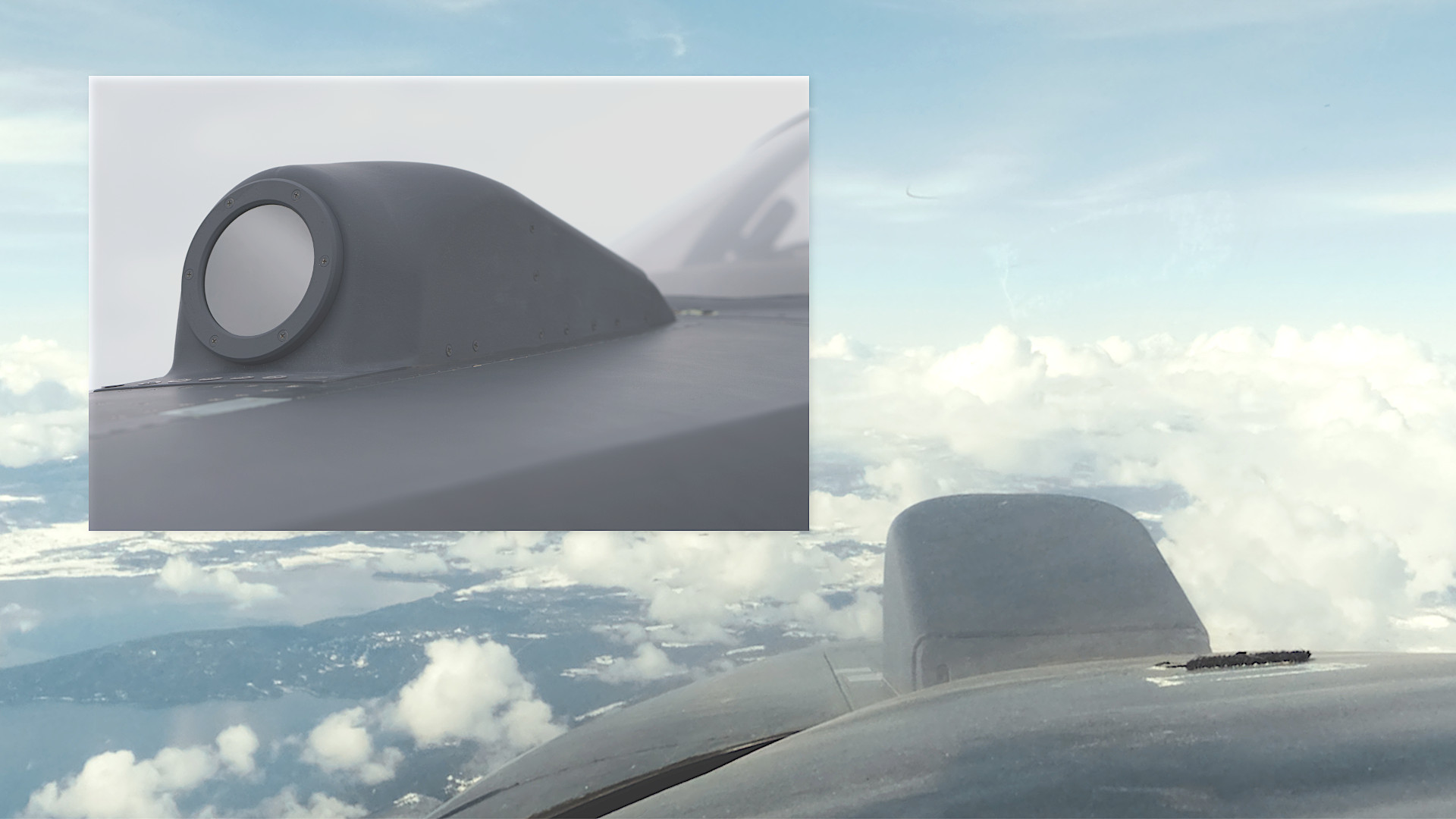Defense contractor Anduril has unveiled a new family of passive infrared sensors called Iris that are tailored for use on aircraft, especially drones. Iris sensors are intended to be readily adaptable for different uses, including as part of missile warning or targeting systems. Iris is being pitched as particularly suitable low-cost option for use as part of an infrared search-and-track system, or IRST, to help crewed and uncrewed aircraft spot and engage aerial threats, especially stealthy ones.
Though Anduril is making this formal announcement now, the Iris family has already been in development for some time. The company told The War Zone that the sensors’ capabilities had already been demonstrated in multiple contexts “through integrations and live-flight tests” on a variety of aircraft, including tactical combat jet types. Pictures at the top of this story and below shows an Iris sensor integrated on top of the nose of a tactical jet, though Anduril declined to disclose what type or the operator. Anduril has stressed that the exact look of the sensor and the available housing options is already evolving significantly from the test configuration seen here.

“Iris leverages Anduril’s proprietary and proven Computational Pixel Imager (CPI) technology that uses processors in every pixel to reduce noise and enable accurate detections at more extreme ranges than previously thought possible,” according to a press release from Anduril. “That capability is facilitated by real-time AI [artificial intelligence] detection and classification that autonomously identifies and tracks hundreds of objects of interest to help operators see potential targets through the noise.”
Iris takes further advantage of Anduril’s previous work on its Wide-Area Infrared System for Persistent Surveillance sensor system, or WISP, which also uses the CPI technology. WISP is currently offered primarily for ground-based and shipboard applications, including as part of counter-drone systems.
The Anduril video below gives a look into the imaging sensor work the company has already done, including with regard to WISP.

“Inherently modular and flexible, Iris offers several configurations across lens type, wavelength, and pixel image format to bring best-in-class imaging performance to any mission set,” the company’s press release adds. “Iris is adaptable to most aircraft, including Autonomous Air Vehicles (AAVs) and uncrewed platforms, to enable autonomous, artificial intelligence-powered image processing at the edge to detect and track hundreds of targets at long range.”
Anduril told us that Iris is available in a largely self-contained package with its own housing for the sensor that can be adapted as required to fit different aircraft mounting requirements, as well as a “processing box” with requisite hardware and software. “In some cases” Iris “can be integrated with existing mission systems,” according to the company.
Altogether, Iris, coupled with CPI technology and the AI-driven processing backend Anduril is offering, seems well suited specifically for use as an IRST system. This is a type of capability that has been seeing a real renaissance in the West, including in the U.S. military, in recent years. The U.S. Navy is acquiring a larger and costlier podded IRST system that utilized a modified drop tank for use on its F/A-18E/F Super Hornets. A similar podded IRST system, called the Legion Pod, has been seen more and more use in the U.S. Air Force, too.


What IRST systems ‘see’ of an aerial target is not impacted by any of that target’s features designed to reduce its radar cross section. In other words, stealthy shaping and radar absorbent materials have no impact on an IRST’s detection capabilities. However, work done to mitigate an aircraft’s infrared signature would have an effect.
IRSTs are similarly immune to radio frequency electronic warfare jamming. They also scan passively, reducing the likelihood a target will even know it has been spotted. All of this offers advantages over typical radars, especially in environments where large numbers of stealthy aircraft or cruise missiles or heavy electronic warfare use is expected.
In addition, IRSTs can be used to complement radars, offering a passive way to detect targets, which radars can then be cued to further investigate and vice-versa. The overall fusion of sensor information can offer higher fidelity tracks of multiple targets simultaneously and just better situational awareness even in complex future battlespaces.
It is worth noting that a single IRST typically can only instantaneously determine bearing to a target by itself, with it being harder to take the information the sensor gathers and figure out the distance to that target. This can be mitigated by networking multiple IRST-equipped platforms together and determining the range via triangulation.

“In a future fight, airborne systems will be faced with numerous targets and threats moving across all domains,” Brian Schimpf, Co-Founder and CEO of Anduril Industries, said in a statement in today’s press release about Iris. “Airborne sensors must be able to rapidly and autonomously detect, track, identify, and classify each of those targets simultaneously.”
In addition, from what we have seen of Iris so far, each individual sensor is more of a ‘staring’ type with a fixed field of view. Many existing IRSTs use a more cumbersome sensor in some kind of gimbaled or similarly articulating mount to allow it to scan a larger area, often telescopically. As note, of course, Iris is intended to be readily adaptable to different mounting arrangements and it is certainly possible that these sensors could be fitted in a gimbal or something similar depending on customer requirements. Iris also looks to benefit from a relatively compact core that would for more flexibility in integration options overall.

At the same time, a ‘staring’ system could still provide useful functionality as an IRST. An array of these sensors could be positioned elsewhere around a single aircraft to provide more coverage, as well. This would be very broadly akin to the Distributed Aperture System (DAS) found on F-35 fighters. A podded system could also be devised with multiple fixed sensors facing in different directions.

A Iris configuration involving multiple individual sensors on a single platform could have functionality as a threat warning system or just to provide additional situational awareness, or even some degree of air-to-ground target detection/targeting capabilities.
Iris’s compact design, whether integrated directly onto a platform or via a pod, could offer other advantages, such a less need to consume physical space inside and airframe. This could make the system easier to add onto smaller platforms and just more flexible in general.
“We designed Iris primarily for new uncrewed and autonomous systems,” Anduril told The War Zone. “As those systems become more widespread, they will need affordable passive sensing solutions that enable long-range detection and discrimination of hundreds of targets simultaneously across all domains, while maintaining high availability and producibility at scale.”
The War Zone has highlighted in the past, especially when discussing the U.S. Air Force’s secretive Off-Board Sensor System (OBSS) program, that drones equipped with IRSTs and networked together could be very valuable in future air combat scenarios. A group of such drones operating forward of friendly forces could help more rapidly spot and track large numbers of targets across a broad area, and feed that information to other crewed and uncrewed platforms to actually engage those threats.
Even a smaller number of uncrewed aircraft with passive IRST systems could help extend the sensor reach of crewed aircraft and also help keep them further away, or at least better concealed, from potential threats. The U.S. military and other defense contractors in the United States beyond Anduril have been actively exploring these kinds of concepts of operations for years now already. Integrated or podded IRST systems are already increasingly being seen on advanced drones.


Interestingly, everything we’ve seen so far about Iris, including the use of compact ‘staring’ type sensors and the potential for a multi-sensor pod option, is very much in line with Lockheed Martin’s TacIRST system, which was unveiled back in 2022.

To date, private adversary air support contractor TacAir was the first and is still only known user of TacIRST, having integrated that system onto some of its upgraded F-5AT adversary jets. Those jets carry a single sensor on top of the nose, an overall configuration that is extremely similar to what is seen in the pictures Anduril has released so far in relation to Iris. It’s not hard to see how the overall adversary air industry, which has grown significantly in recent years and is being called upon to replicate ever-more advanced threats, would be interested in additional IRST options.

“To date, we have integrated Iris onto aircraft that may be of interest to multiple potential customers and have plans to integrate and prove-out Iris’s performance on a number of other existing crewed platforms of interest to additional customers,” Anduril said when asked about whether there were any customers or potential customers for the system now.
The company also raised the point that “Iris can be integrated with a vast range of existing crewed platforms as part of ongoing modernization and upgrade efforts.”
Being able to retrofit existing fighter aircraft with an IRST capability, even if it is not as elaborate or capable as much larger and more expensive podded systems, could be a major win for America’s air arms and allied ones around the globe.
As already noted, there has been a major revival of interest in IRSTs, in general, in the West in recent years, spurred on in large part by the growing proliferation of stealthy aircraft, crewed and uncrewed, and cruise missiles around the world. The demand then for new and more capable IRST systems, and ones that can be readily added to a host of existing and future platforms like Anduril’s Iris, only looks set to expand.
Contact the author: joe@twz.com
